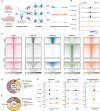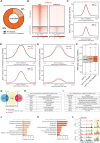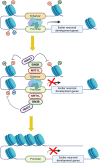MYT1L is required for suppressing earlier neuronal development programs in the adult mouse brain
- PMID: 37100461
- PMCID: PMC10234307
- DOI: 10.1101/gr.277413.122
MYT1L is required for suppressing earlier neuronal development programs in the adult mouse brain
Abstract
In vitro studies indicate the neurodevelopmental disorder gene myelin transcription factor 1-like (MYT1L) suppresses non-neuronal lineage genes during fibroblast-to-neuron direct differentiation. However, MYT1L's molecular and cellular functions in the adult mammalian brain have not been fully characterized. Here, we found that MYT1L loss leads to up-regulated deep layer (DL) gene expression, corresponding to an increased ratio of DL/UL neurons in the adult mouse cortex. To define potential mechanisms, we conducted Cleavage Under Targets & Release Using Nuclease (CUT&RUN) to map MYT1L binding targets and epigenetic changes following MYT1L loss in mouse developing cortex and adult prefrontal cortex (PFC). We found MYT1L mainly binds to open chromatin, but with different transcription factor co-occupancies between promoters and enhancers. Likewise, multiomic data set integration revealed that, at promoters, MYT1L loss does not change chromatin accessibility but increases H3K4me3 and H3K27ac, activating both a subset of earlier neuronal development genes as well as Bcl11b, a key regulator for DL neuron development. Meanwhile, we discovered that MYT1L normally represses the activity of neurogenic enhancers associated with neuronal migration and neuronal projection development by closing chromatin structures and promoting removal of active histone marks. Further, we showed that MYT1L interacts with HDAC2 and transcriptional repressor SIN3B in vivo, providing potential mechanisms underlying repressive effects on histone acetylation and gene expression. Overall, our findings provide a comprehensive map of MYT1L binding in vivo and mechanistic insights into how MYT1L loss leads to aberrant activation of earlier neuronal development programs in the adult mouse brain.
© 2023 Chen et al.; Published by Cold Spring Harbor Laboratory Press.
Figures







Similar articles
-
MYT1L deficiency impairs excitatory neuron trajectory during cortical development.Nat Commun. 2024 Nov 27;15(1):10308. doi: 10.1038/s41467-024-54371-2. Nat Commun. 2024. PMID: 39604385 Free PMC article.
-
Myt1l safeguards neuronal identity by actively repressing many non-neuronal fates.Nature. 2017 Apr 13;544(7649):245-249. doi: 10.1038/nature21722. Epub 2017 Apr 5. Nature. 2017. PMID: 28379941 Free PMC article.
-
Myt1 family recruits histone deacetylase to regulate neural transcription.J Neurochem. 2005 Jun;93(6):1444-53. doi: 10.1111/j.1471-4159.2005.03131.x. J Neurochem. 2005. PMID: 15935060 Free PMC article.
-
MYT1L in the making: emerging insights on functions of a neurodevelopmental disorder gene.Transl Psychiatry. 2022 Jul 22;12(1):292. doi: 10.1038/s41398-022-02058-x. Transl Psychiatry. 2022. PMID: 35869058 Free PMC article. Review.
-
CoREST-like complexes regulate chromatin modification and neuronal gene expression.J Mol Neurosci. 2006;29(3):227-39. doi: 10.1385/JMN:29:3:227. J Mol Neurosci. 2006. PMID: 17085781 Review.
Cited by
-
MYT1L deficiency impairs excitatory neuron trajectory during cortical development.Nat Commun. 2024 Nov 27;15(1):10308. doi: 10.1038/s41467-024-54371-2. Nat Commun. 2024. PMID: 39604385 Free PMC article.
-
Lifespan in rodents with MYT1L heterozygous mutation.Sci Rep. 2025 Feb 10;15(1):4998. doi: 10.1038/s41598-025-88462-x. Sci Rep. 2025. PMID: 39930023 Free PMC article.
-
Lifespan in rodents with MYT1L heterozygous mutation.Res Sq [Preprint]. 2024 Dec 17:rs.3.rs-5140229. doi: 10.21203/rs.3.rs-5140229/v1. Res Sq. 2024. Update in: Sci Rep. 2025 Feb 10;15(1):4998. doi: 10.1038/s41598-025-88462-x. PMID: 39764117 Free PMC article. Updated. Preprint.
-
A survey of hypothalamic phenotypes identifies molecular and behavioral consequences of MYT1L haploinsufficiency in male and female mice.bioRxiv [Preprint]. 2024 Nov 25:2024.11.25.625294. doi: 10.1101/2024.11.25.625294. bioRxiv. 2024. Update in: Horm Behav. 2025 Aug;174:105796. doi: 10.1016/j.yhbeh.2025.105796. PMID: 39651298 Free PMC article. Updated. Preprint.
-
MYT1L haploinsufficiency in human neurons and mice causes autism-associated phenotypes that can be reversed by genetic and pharmacologic intervention.Mol Psychiatry. 2023 May;28(5):2122-2135. doi: 10.1038/s41380-023-01959-7. Epub 2023 Feb 14. Mol Psychiatry. 2023. PMID: 36782060 Free PMC article.
References
-
- Bainor AJ, Saini S, Calderon A, Casado-Polanco R, Giner-Ramirez B, Moncada C, Cantor DJ, Ernlund A, Litovchick L, David G. 2018. The HDAC-associated Sin3B protein represses DREAM complex targets and cooperates with APC/C to promote quiescence. Cell Rep 25: 2797–2807.e8. 10.1016/j.celrep.2018.11.024 - DOI - PMC - PubMed
Publication types
MeSH terms
Substances
Grants and funding
LinkOut - more resources
Full Text Sources
Molecular Biology Databases
Miscellaneous
